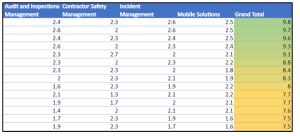Considerations when selecting an EHS MIS tool
Posted: February 22nd, 2024
Authors: Noah Z.Management information systems (MIS) are used for the coordination, communication, and analysis of information in an organization. There are multiple software solutions out on the market and the MIS selection process for Environmental Health and Safety (EHS) compliance systems can be daunting, but leveraging objective data in the selection process can help ensure the decision is the right one for both the organization and the end users. It can also unearth important requirements that an organization may have been unaware of. Finding the right organizational fit and high user adoption is the goal.
Leveraging Market Data in the Selection Process
Using data to support the selection process can ensure the decision is robust. The difficulty is deciding what data to use, especially when solution demos or previous experience with a tool might be the only data point an organization may have prior to implementation. Subjective data collected from exciting solution demos, aversion to known systems, emotional attachment, or political factors can skew the decision-making process.
The selection process can be data driven by scoring different vendor modules against an organization’s goals. By using market research tools like the Verdantix, Green Quadrant: EHS Software 2023 report, we can leverage data on the strengths of the vendor down to specific modules, which can be adjusted to fit the organization making the selection.
Table 1
ALL4 Dynamic Selection Analysis

Source: Data from Green Quadrant: EHS Software 2021, 26 January 2021. Table created by ALL4.
Determining the Right Fit for the Organization
The MIS tool needs to be as closely aligned as possible with business processes in the organization. This can help ensure quality data and organizational adoption. Additional organizational considerations include:
- Variety of tools
- If a software vendor offers a suite of five tools and four of the five tools align well with organizational processes, it may be the best overall option.
- Planning for tools that are vital to implement now, and those that can be planned for in the future.
- Grouping the tools implemented in the most efficient way.
- Configurability
- How configurable the software is will be a major consideration impacting the implementation; if the organizational process is complex, configurability may be key in matching the software to intended use.
- If the organization is amenable to adapting or updating their process to be more closely aligned with a tool, that may impact which tools are available to select.
To find out more about the different tiers of digital solutions see the 4TR article.
Determining the Right Fit for the User
When selecting an MIS tool another major consideration is how well the system fits the end user in the organization. Simplicity in user interface and user experience is usually the best option and can have a significant role in user adoption. Additional user considerations include:
- Ease of use
- Availability of mobile applications.
- Planning for user roles that are in the system frequently compared to those rarely in the system.
- Human-computer interaction; optimizing the tool for users with accessibility needs such as color-blindness or different levels of technological experience and comfort.
- Ease of maintainability by administrators
- Allowing business administrators to help manage the system can be a benefit to the organization, while the IT team can support with best practices.
- The business users may understand their data needs better than the software vendor or an IT team.
- User experience issues may be more rapidly addressed by business administrators rather than having to work with the vendor or an IT team.
- Allowing business administrators to help manage the system can be a benefit to the organization, while the IT team can support with best practices.
Conclusion
An MIS tool can improve processes and save users time, however, selecting the tool that best fits the organization and the user is difficult. By using requirements analysis tools that leverage market data we can help ensure the right tool for both users and the organization is selected. We have built requirements analysis and selection tools that incorporate this dynamic analysis to make the selection process clearer and help simplify the decision-making process for organizations by tailoring the tool to their organization.
ALL4’s Digital Solutions Practice has extensive experience helping clients scope, select, implement, maintain, and upgrade various types of digital tools. If you would like to discuss a digital solution for your company, please contact Noah Zetocha at nzetocha@all4inc.com or 402-853-2538.

